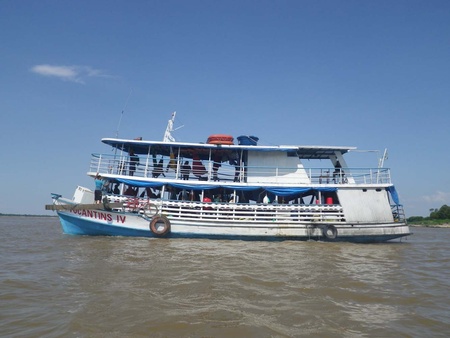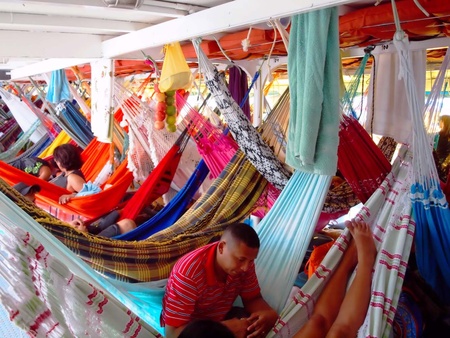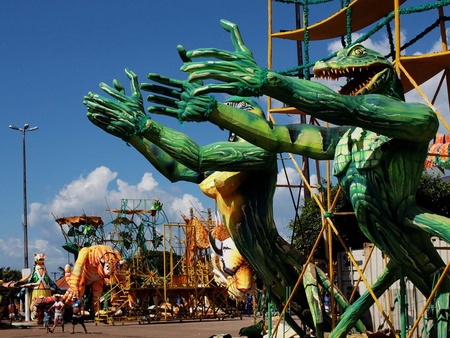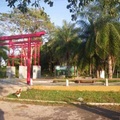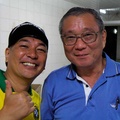There are many strange festivals around the world, but there is one in the Amazon jungle that is unique. This is "Boi Bumba," which takes place every June in Parintins, the second largest city in the state of Amazonas, with a population of 110,000.
Transportation to Parintins is by boat or plane (propeller plane). There is no land route to the city, as it is cut off by the Amazon River and the jungle. It is truly an isolated island.
Every year during the Boi Bumba season, a huge number of tourists from all over the world flock to the island. A huge number of boats arrive at the town's pier from upstream, from Manaus in the state of Amazonas, and downstream, from Belem in the state of Pará.
During the festival, brightly colored hammocks are lined up on the many boats floating on the Amazon River. These are sleeping accommodations for tourists who cannot stay in hotels, and during the day they sway in the Amazon breeze to soothe the visitors' tiredness.
Normally, there are only two scheduled flights a day, one in the morning and one in the evening, but during this time of year, propeller planes make multiple round trips from the state capital, Manaus, to transport spectators. Tickets for the Boi Bumba, which takes place at Bumbodoromo in the center of the city, are bought up by major travel agencies from São Paulo and other areas, making them difficult to obtain and expensive every year.
The Amazon's biggest festival, Boi Bumba, is a song and dance competition held over three days in the last week of June every year between two teams, Garantido (team colors are red, which represents the white bull) and Capricioso (team colors are blue, which represents the black bull). The highlights are the dance that incorporates the rhythm and movements of the Indians who have lived in the jungle for a long time, and the original floats that are over 10 meters tall.
The performance, which was full of unity and involved the audience, was a masterpiece. The venue was filled with a heat that rivaled that of the Rio Carnival. The Bumbodoromo was split in half, colored red and blue, and participants spent three crazy days dancing and singing while cheering on their favorite team. Of course, the uniforms were all red or blue.
It is no exaggeration to say that many of Parintins' citizens live for Boi Bumba for a whole year. When you walk around Parintins, you will notice that there are an extremely large number of blue and red houses. The cars that run through the city are also red or blue. Many people wear red or blue shirts. Wearing red or blue on a daily basis is a sign of loyalty to the team, and it is not uncommon for people to paint their entire houses red or blue. Gas cylinders that are used at home are also available in two colors, red and blue. Also, at Christmas, blue Santa Claus dolls are sold next to red Santa Claus dolls as a matter of course.
When you arrive at Parintins airport, you will be greeted by many signs. What makes Parintins different from other cities in Brazil is that all the signs and advertisements are made in two colors, red and blue. Have you ever seen a blue Coca-Cola sign? In Parintins, you can see blue Coke signs all over the city. The red-based logo of Bradesco Bank and the blue-based logo of Kaiser Beer are both equally present in this city. Parintins is probably the only place in the world where you can see a blue Coca-Cola sign.
Attached to the Bumbodoro is the Boi Bumba Museum, which opened in 2014. The building is full of things to see, including costumes from dancers throughout the ages, as well as a wealth of photographs and documents.
"This costume has a fan attached to the collar. It is a design influenced by Japan. The horns of this cow are black, white, and yellow. The black represents Indians, the white represents Caucasians, and the yellow represents Japanese people," our guide told us when we visited this place in March 2014.
In front of the Bumbodoromo, where Boi Bumba takes place, there is a Japanese-style square with a golden bust. It is no secret that this bust is of a Japanese man who made great contributions to the development of the Amazon jungle. His name is Tsukasa Uetsuka. No one in this town knows his name.
During my three years in Brazil as a JICA senior volunteer for Japanese communities, I visited Parintins nearly 30 times, and the more I visited, the more I realized the close relationship between this town and Japan. Many people call this very peaceful and laid-back town a "jungle paradise," and it's easy to see why, as it is a place filled with various charms.
© 2016 Toshimi Tsuruta


